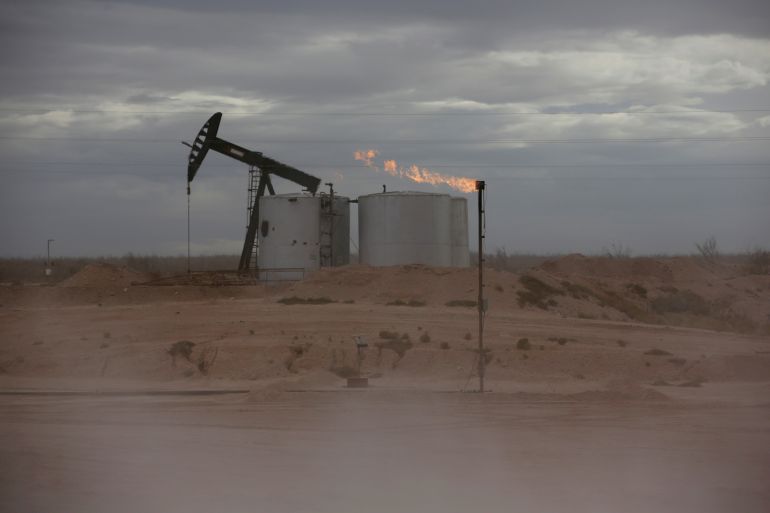Fossil fuel producers’ plans far exceed 1.5C climate target
UNEP’s Production Gap report finds countries plan to produce some 110 percent more fossil fuels in 2030.

The world needs to cut by more than half its production of coal, oil and gas in the coming decade to maintain a chance of keeping global warming from reaching dangerous levels, according to a new United Nations-backed study.
The report published by the UN Environment Programme (UNEP) on Wednesday found that while governments have made ambitious pledges to curb greenhouse gas emissions, they are still planning to extract double the amount of fossil fuels in 2030 than what would be consistent with the 2015 Paris climate accord’s goal of keeping the global temperature rise below 1.5 degrees Celsius (2.7 degrees Fahrenheit).
Keep reading
list of 3 itemsThe end of the internal combustion engine?
Cities are at the front lines of climate and migration
The Production Gap report, which was released 10 days before the COP26 climate summit – billed as key to the viability of the Paris Agreement temperature goals – analysed 15 major fossil fuel producers: Australia, Brazil, Canada, China, Germany, India, Indonesia, Mexico, Norway, Russia, Saudi Arabia, South Africa, the United Arab Emirates, the United Kingdom and the United States.
It said government fossil fuel production plans this decade are “dangerously out of sync” with the emissions cuts needed, warning that countries plan to produce, in total, some 110 percent more fossil fuels in 2030 than would be consistent with limiting the degree of warming to 1.5C, and 45 percent more than is consistent with 2C.
🚨#ProductionGap report shows that 🌎 governments plan to produce more than double the amount of fossil fuels in 2030 than would be consistent with limiting warming to 1.5°C!https://t.co/JuLOZGabuI pic.twitter.com/dI2zUNSQtw
— UN Environment Programme Asia Pacific (@UNEP_AsiaPac) October 20, 2021
Global gas production is projected to increase the most between 2020 and 2040.
Countries have directed more than $300bn in new funds towards fossil fuel activities since the beginning of the pandemic – more than they have towards clean energy.
“The research is clear: Global coal, oil and gas production must start declining immediately and steeply to be consistent with limiting long-term warming to 1.5C,” said Ploy Achakulwisut, a lead report author from the Stockholm Environment Institute.
“However, governments continue to plan for and support levels of fossil fuel production that are vastly in excess of what we can safely burn.”
The 2015 Paris deal saw countries commit to limiting warming to between 1.5C and 2C through sweeping emissions cuts.
Under the deal, every signatory must submit renewed emissions-cutting plans – known as National Determined Contributions, or NDCs – every five years.
In an assessment last month, the UN said that taken together, countries’ latest NDCs – assuming they are fulfilled – put Earth on course to reach a “catastrophic” 2.7C of warming by 2100.
The organisers of COP26, which starts in Glasgow on October 31, say they want the summit to keep the 1.5C temperature goal within reach.
Michael Lazarus, a co-author of Wednesday’s report, said the difference between countries’ NDCs and production plans was “the major mismatch” in climate diplomacy right now.
“Even in the face of inevitable decarbonisation away from fossil fuels, some countries are speeding up their investments in activities to promote fossil fuel production, vowing to remain the last ones standing,” he said.
Last week, the International Energy Agency said the use of coal – the most polluting fossil fuel – had in fact increased since the start of the COVID-19 pandemic in early 2020. In May, it said that no new oil and gas production was compatible with the 1.5C target.
Miguel Munoz Cabre, a senior scientist at the Stockholm Environment Institute said countries “need to take action now.”
“And this needs to be done in a concerted manner,” Cabre said.
“We cannot just ask one country or another to do it. This is an international problem that … cannot be solved without international cooperation,” he added.
ALERT: to limit warming to 1.5°C global fossil fuel production must start declining immediately and steeply. Instead, governments’ plans foresee global production increasing out to at least 2040.
Find out more at https://t.co/XJ7dPQtdxA#ProductionGap pic.twitter.com/cE8lt7jHDJ
— IISD (@IISD_news) October 20, 2021